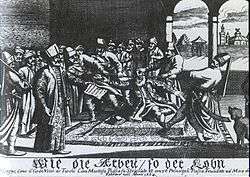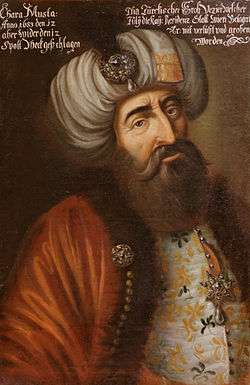Kara Mustafa Pasha
| Merzifonlu Kara Mustafa Pasha | |
|---|---|
|
Kara Mustafa Pasha, painted shortly after the Battle of Vienna (1683) | |
| Grand Vizier of the Ottoman Empire | |
|
In office 19 October 1676 – 25 December 1683 | |
| Monarch | Mehmed IV |
| Preceded by | Köprülü Fazıl Ahmed Pasha |
| Succeeded by | Bayburtlu Kara Ibrahim Pasha |
| Personal details | |
| Born |
1634 or 1635 Merzifon, Rum Eyalet |
| Died |
25 December 1683 Belgrade, Budin Eyalet |
| Nationality | Ottoman |
| Relations |
Köprülü Mehmed Pasha (father-in-law) Köprülü Fazıl Ahmed Pasha (brother-in-law) Köprülü Fazıl Mustafa Pasha (brother-in-law) |
| Origins | Turkish |
| Family | Köprülü family |
| Military service | |
| Allegiance |
|
| Service/branch |
|
| Years of service | 1660s–1683 |
| Rank |
Kapudan Pasha (1666–70) Commander-in-Chief (1676–83) |
| Battles/wars |
Polish–Ottoman War (1672–76)
|
Merzifonlu Kara Mustafa Pasha (Ottoman Turkish: مرزيفونلى قره مصطفى پاشا, Merzifonlı Ḳara Muṣṭafā Paşa; "Mustafa Pasha the Courageous of Merzifon"; 1634/1635 – 25 December 1683) was an Ottoman military leader and grand vizier who was a central character in the Ottoman Empire's last attempts at expansion into both Central and Eastern Europe.
Early life and career

Born to Albanian parents[1][2] in Merzifon, Mustafa was educated in the household of Mehmed Köprülü and married into the powerful Köprülü family.[3] In 1659, he became governor of Silistria and subsequently held a number of important posts. Within ten years, he was acting as deputy for his brother-in-law, the grand vizier Köprülü Fazıl Ahmed Pasha when absent from the Sultan's court.[3]
He served as a commander of ground troops in a war against Poland, negotiating a settlement with Jan Sobieski in 1676 that added the province of Podolia to the empire. The victory enabled the Ottomans to transform the Cossack regions of the southern Ukraine into a protectorate. When his brother-in-law Köprülü Fazıl Ahmed Pasha died that same year, Mustafa succeeded him as grand vizier.[3]
Kara Mustafa led several successful campaigns into Ukraine, attempting to shore up the position of the Cossack state of Right-Bank Ukraine, then an Ottoman vassal. He established Ottoman garrisons in many of Ukraine's cities, and conquered the traditional Cossack capital of Chyhyryn, which had been under Russian occupation.[4]
Battle of Vienna
In 1683, he launched a campaign northward into Austria in a last effort to expand the Ottoman Empire after more than 150 years of war. By mid-July, his 100,000-man army had besieged Vienna (guarded by 10,000 Habsburg soldiers), following in the footsteps of Suleiman the Magnificent in 1529. By September, he had taken a portion of the walls and appeared to be on his way to victory.
But on 12 September 1683, a Polish army under King Jan Sobieski took advantage of dissent within the Ottoman military command and poor disposition of his troops, winning the Battle of Vienna with a devastating flank attack led by Sobieski's Polish Winged Hussars. The Ottomans retreated into Hungary, much of which was subsequently conquered by the Habsburgs and their Holy League allies.
The defeat cost Mustafa his position, and ultimately, his life. On 25 December 1683, Kara Mustafa was executed in Belgrade at the order of Mehmed IV. He suffered death by strangulation with a silk cord, which was the method of capital punishment inflicted on high-ranking persons in the Ottoman Empire. His last words were, "Am I to die?" and "As God pleases."[3]
Legacy

The Foundation of Merzifonlu Kara Mustafa Pasha was one of the largest foundations ever founded both in Ottoman Empire and Turkey. According to the official records, it was last managed by the descendants of Kara Mustafa Pasha. The last few managers of the foundation were Mustafa Pasha's descendant Ahmed Asım Bey (born 1844), his son Mehmed Nebil Bey (born 1888) (also known as Merzifonlu Karamustafaoğlu or Merzifonlu Karamustafapaşaoğlu), and his son, the Turkish painter Doğan Yılmaz Merzifonlu Karamustafaoğlu, better known as Yılmaz Merzifonlu (1928–2010), until 1976. The "Merzifonlu Karamustafaoğlu" family name ended with the marriage of Yılmaz Merzifonlu's only daughter, Abide Tuğçe Mit.[5] Kara Mustafa Pasha's family and descendant tree can be found via Turkey's Directorate General of Foundations.[6]
In media
In the 2012 Polish and Italian historical drama film September Eleven 1683 about the Battle of Vienna, Kara Mustafa Pasha is portrayed by Italian actor Enrico Lo Verso.
See also
- Köprülü era of the Ottoman Empire
- Köprülü family
- List of Ottoman Grand Viziers
References
- ↑ Hamilton, Alastair; Groot, Alexander Hendrik de; Boogert, Maurits H. Van Den (2000-01-01). Friends and Rivals in the East: Studies in Anglo-Dutch Relations in the Levant from the Seventeenth to the Early Nineteenth Century. BRILL. ISBN 9004118543.
- ↑ Evliya Çelebi (ed. by von Hammer-Purgstall) (1834-01-01). The Travels of Evliya Efendi. p. 156.
- 1 2 3 4 The Siege of Vienna, John Stoye, p. 18.
- ↑ Kołodziejczyk, Dariusz (2004). "Introduction". The Ottoman Survey Register of Podolia (ca. 1681) Part I: Text, Translation, and Commentary. Harvard University Press. pp. 3–10.
- ↑ "Son Merzifonlu o filme karşı değil". www.hurriyet.com.tr. Retrieved 2016-03-24.
- ↑ http://www.vgm.gov.tr/ (Turkish)
Further reading
| Wikimedia Commons has media related to Kara Mustafa Pasha. |
- Olnon, Merlijn (2003). "'A Most Agreeable and Pleasant Creature'? Merzifonlu Kara Mustafa Paşa in the Correspondence of Justinus Colyer (1668-1682)". Oriente Moderno. 22 (New Series): 649–669.
| Political offices | ||
|---|---|---|
| Preceded by Köprülü Fazıl Ahmed Pasha |
Grand Vizier of the Ottoman Empire 19 October 1676 – 25 December 1683 |
Succeeded by Bayburtlu Kara Ibrahim Pasha |
